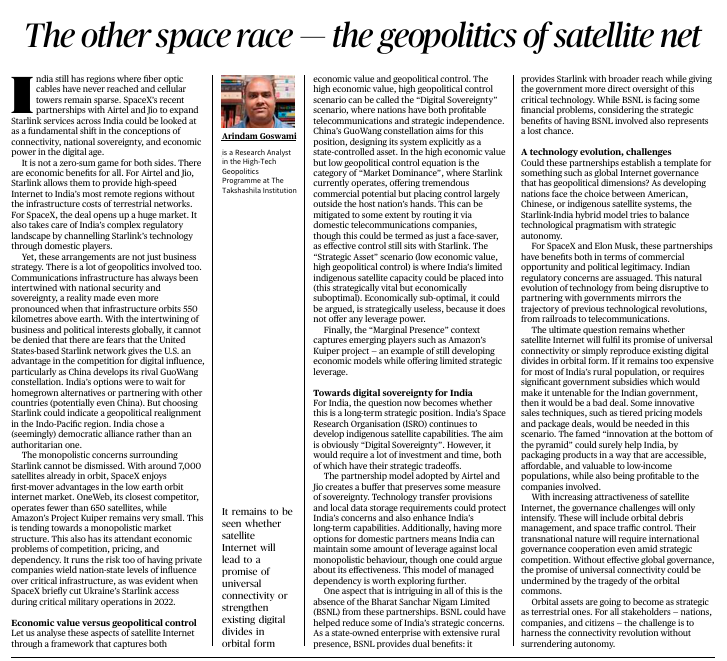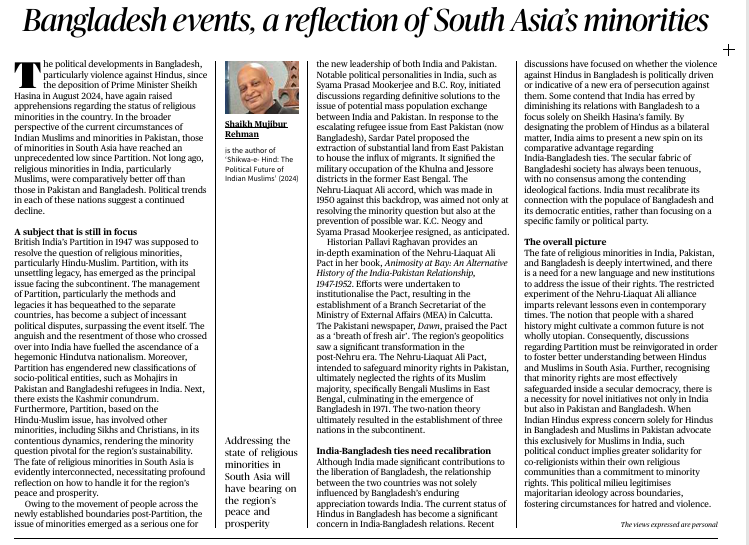GS 3: Developments in Science and Technology,Applications of scientific developments in everyday life,Effects of scientific developments in everyday life
Introduction: The Growing Role of Satellite Internet
- India has remote regions where fiber optics and cellular towers have not reached.
- SpaceX’s Starlink partnership with Airtel and Jio could be a major shift in connectivity, national sovereignty, and digital power.
Mutual Economic Benefits of Starlink Expansion
- Airtel and Jio gain high-speed internet for remote areas without infrastructure costs.
- SpaceX gets a large market in India and navigates regulatory challenges by partnering with domestic players.
Geopolitical Considerations
- Communication infrastructure is tied to national security and sovereignty.
- The U.S. and China are in a digital infrastructure race; India’s choice of Starlink over alternatives like China’s GuoWang suggests a pro-democratic alignment.
Monopoly and Competition Concerns
- Starlink already has around 7,000 satellites, giving it a significant first-mover advantage.
- Its competitor, Amazon’s Kuiper, has fewer than 600 satellites.
- Concerns exist over monopolistic pricing, but competition from OneWeb, BSNL, and other players could balance the market.
Different Strategic Scenarios for India’s Approach to Satellite Internet
- “Digital Sovereignty” (High economy, high geopolitical control): India prioritizes financial independence and strategic autonomy.
- “Market Dominance” (High economy, low geopolitical control): Starlink operates freely, benefiting the market but with limited Indian government control.
- “Strategic Asset” (Low economy, high geopolitical control): India keeps limited satellite access but strategically controls it.
- “Marginal Presence” (Low economy, low geopolitical control): India remains dependent on foreign technology without much leverage.
India’s Push for Digital Sovereignty
- ISRO continues satellite projects, but self-reliance takes time and investment.
- Partnerships like BSNL and Starlink can help balance strategic control while ensuring internet expansion.
The Future of Satellite Internet in India
- Key question: Will satellite internet provide universal connectivity or just strengthen digital divides?
If reliant on subsidies, it may become unaffordable for large-scale Indian deployment. - Packaging satellite services innovatively for affordability will be crucial.
Strategic Policy Implications
- India’s increasing interest in digital governance highlights the need for independent satellite policies.
- Governance will influence digital control between national and international players.
- The competition between nations in satellite communication mirrors past technological revolutions like railways and telecom.
Conclusion: Balancing Connectivity & Strategic Autonomy
- India must balance Starlink’s benefits with regulatory control.
- BSNL’s role in the satellite market could counterbalance foreign dominance.
Managing the geopolitical and economic impacts of satellite internet is crucial for India’s long-term digital sovereignty.
Mains practice question:
The expansion of satellite-based internet services has significant geopolitical and economic implications, particularly for developing nations like India. Discuss the challenges and opportunities associated with such partnerships in the context of national sovereignty, digital autonomy, and economic growth.” (250 words, 15 marks)
Religious Minorities in South Asia
Introduction: Religious Minorities in South Asia
- Political developments in Bangladesh, particularly violence against Hindus after Sheikh Hasina’s deposition (August 2024), have raised concerns about the state of religious minorities.
- Religious minorities, especially Muslims in India, were previously better off than those in Pakistan and Bangladesh.
- However, recent political trends show a continued decline in the status of religious minorities in all three nations.
The Lingering Impact of Partition on Religious Minorities
- Partition (1947) was intended to resolve religious conflicts, particularly Hindu-Muslim tensions.
- However, it created long-term instability, including:
- Displacement of populations.
- Lingering tensions over migration and identity.
- Reclassification of Muslims as second-class citizens in India.
- The Kashmiri conflict.
- Displacement of populations.
- While Partition initially provided a resolution mechanism, it also led to new forms of discrimination and marginalization.
Historical Context: Nehru-Liaquat Pact and Population Exchange Proposals
- The Nehru-Liaquat Pact (1950) was an attempt to protect religious minorities in India and Pakistan.
- It aimed at safeguarding minority rights and preventing mass migration.
- Alternative proposals, such as Sardar Patel’s idea of sending East Pakistani Hindus to India and housing Indian Muslims in East Pakistan, were also considered.
- While the pact provided a framework, its impact was limited, and religious minorities in both countries continued to suffer discrimination.
Contemporary Political Climate in Bangladesh and Its Regional Impact
- The recent instability in Bangladesh (after Sheikh Hasina’s removal) has worsened conditions for Hindus.
- In India, discussions have emerged about whether the violence against Hindus in Bangladesh is politically driven or due to local conflicts.
- Some in India argue that reducing ties with Bangladesh might help, while others believe that diplomatic engagement is necessary to protect Hindus.
The Broader Reality of Religious Minorities in South Asia
- The challenges faced by religious minorities in India, Pakistan, and Bangladesh are interconnected.
Key issues include:
- Marginalization of Hindus in Bangladesh and Pakistan.
- Discrimination against Muslims in India.
- Failure of regional cooperation to effectively safeguard minority rights.
- The Nehru-Liaquat Pact model is outdated, and a new approach is needed to secure minority rights in the modern era.
Need for a New Framework for Minority Rights
- Addressing minority issues requires shared regional responsibility rather than unilateral policies by individual governments.
- There is a need for:
- Better legal protections for minorities.
- International cooperation on religious freedoms.
- Reforms in domestic policies to prevent discrimination.
- Better legal protections for minorities.
- Without such measures, religious minorities in South Asia will continue to face persecution and instability.
Conclusion: Balancing Geopolitical Interests with Minority Protections
- India must ensure that its diplomatic policies with Bangladesh do not ignore the plight of minorities.
- Bangladesh’s secular institutions must play a role in protecting Hindus.
More effective governance and legal safeguards are needed to ensure religious minorities across South Asia are protected from political instability and violence.
MAINS PRACTICE QUESTION:
“The post-Partition status of religious minorities in South Asia continues to shape political and social dynamics in the region. Analyze the historical and contemporary challenges faced by religious minorities in India, Pakistan, and Bangladesh.” (250 words, 15 marks)



